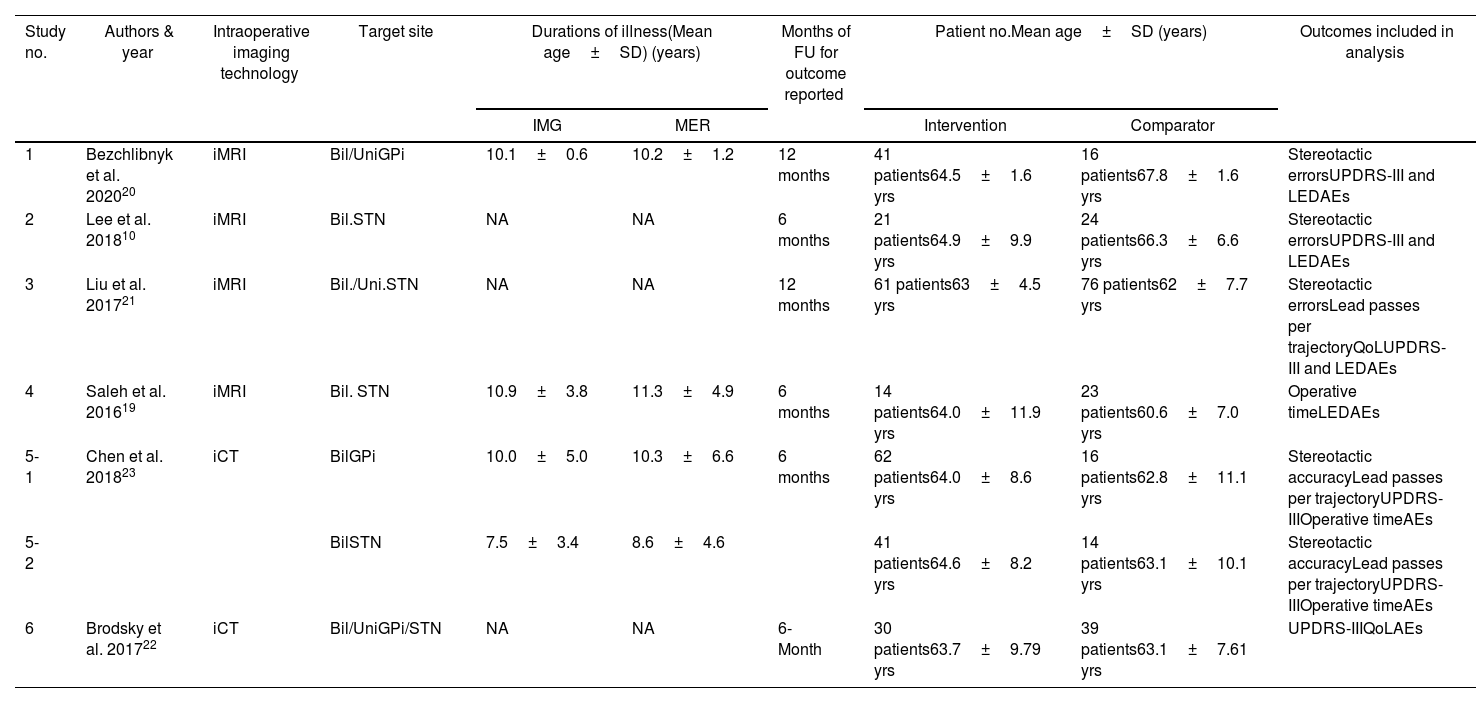Traditionally, most centers would use microelectrode recording (MER) to refine targeting in deep brain stimulation (DBS) surgery. In recent years, intraoperative imaging (IMG) guided DBS has become an alternative way to verify lead placement. Currently, there is still controversy surrounding the necessity of MER or IMG for DBS. This meta-analysis aims to explore lead accuracy, clinical efficacy and safety between IMG and MER guided DBS for Parkinson's disease (PD).
MethodsPubMed, Embase, Web of Science, Cochrane Library were searched up to Mar, 2021 for studies reporting comparisons between IMG and MER guided DBS for PD. Subgroup analysis was conducted to assess effects of different IMG technology and DBS targeting site.
ResultsSix studies, comprising of 478 patients were included in our analysis. The mean difference between the two implantation techniques in stereotactic accuracy, lead passes per trajectory, improvement% of Unified Parkinson's Disease Rating Scale part III and levodopa equivalent daily dose were −0.45 (95% confidence interval, CI=−1.11 to 0.20), −0.18 (95% CI=−0.41 to 0.06), 3.40 (95% CI=−5.36 to 12.16), and 5.00 (95% CI=−1.40 to 11.39), respectively. No significant differences were observed in each adverse event and operation/procedure time between the two implantation techniques.
ConclusionsBoth IMG and MER guided DBS offered effective control of motor symptoms for PD. Besides, IMG guided is comparable to MER guided DBS, in terms of safety, accuracy and efficiency. It is recommended for each hospital to select DBS guidance technology based on available resources and equipment.
Tradicionalmente, la mayoría de los centros usaban los microelectrodos de registro (microelectrode recording [MER]) para mejorar la orientación en la cirugía mediante la estimulación cerebral profunda (deep brain stimulation [DBS]). En los últimos años, la DBS orientada mediante imágenes intraoperatorias (intraoperative imaging guided [IMG]) se ha convertido en una forma alternativa de verificar la colocación de los electrodos. Hoy en día, todavía existe controversia en torno al uso de MER o IMG para realizar una DBS. Este metaanálisis tiene como objetivo explorar la precisión de los electrodos, la eficacia clínica y la seguridad entre la DBS guiada mediante IMG y MER en el tratamiento de la enfermedad de Parkinson (EP).
MétodosSe realizaron búsquedas en PubMed, Embase, Web of Science y Cochrane Library hasta marzo de 2021 para localizar estudios que informasen sobre comparaciones entre la DBS guiada mediante IMG y la guiada mediante MER en la EP. Se realizó un análisis de subgrupos para evaluar los efectos de una tecnología IMG y una ubicación DBS guiada diferentes.
ResultadosEn nuestro análisis hemos incluido seis estudios con 478 pacientes. La diferencia media entre las dos técnicas de implantación en la precisión estereotáctica, los pasos del electrodo por trayectoria, el porcentaje de mejora de la escala unificada de clasificación de la enfermedad de Parkinson, parteIII, y la dosis diaria equivalente de levodopa fueron −0,45 (intervalo de confianza del 95% [IC 95%]: −1,11 a 0,20), −0,18 (IC 95%: −0,41 a 0,06), 3,40 (IC 95%: −5,36 a 12,16) y 5,00 (IC 95%: −1,40 a 11,39), respectivamente. No se observaron diferencias significativas en cada evento adverso y tiempo de operación/procedimiento entre las dos técnicas de implantación.
ConclusionesTanto la DBS guiada mediante IMG como la guiada mediante MER ofrecieron un control eficaz de los síntomas motores de la EP. Además, la DBS orientada guiada por IMG es comparable a la orientada guiada por MER en cuanto a seguridad, precisión y eficiencia. Se recomienda que cada hospital seleccione la tecnología DBS guiada en función de los recursos y del equipamiento disponibles.
Article

If it is the first time you have accessed you can obtain your credentials by contacting Elsevier Spain in suscripciones@elsevier.com or by calling our Customer Service at902 88 87 40 if you are calling from Spain or at +34 932 418 800 (from 9 to 18h., GMT + 1) if you are calling outside of Spain.
If you already have your login data, please click here .
If you have forgotten your password you can you can recover it by clicking here and selecting the option ¿I have forgotten my password¿.















